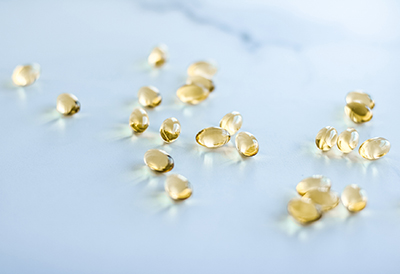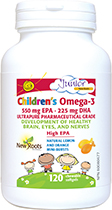Do Kids Need Supplements?
Nutrition is important at every age; however, during childhood years, it is of particular importance to help support growth, learning, and overall development.
I am often asked by parents if their child needs supplements. “What if my child is picky on food: Does he need extra supplements?” Having children myself, I can relate to some of the concerns around nutrient intake, especially when they might love vegetables one day and dislike them the next. I am happy to share some important details about supplements for children and provide some general advice as to whether they should be considered.
Reminder: It is always best to check with your own health-care practitioner or dietitian/nutrition expert if you are looking for personalized advice.
Four Important Nutrients for Children and Teens
1. Healthy Fats
Fat plays a crucial role in brain and body development. Omega-3 fatty acids (docosahexaenoic acid [DHA] and eicosapentaenoic acid [EPA]) are important for the normal development of the nervous system, retina, and brain. In fact, research has shown that improving EPA levels in youth with ADHD helps to improve cognitive symptoms.
 Foods Containing Omega-3s:
Foods Containing Omega-3s:
Omega-3s can be found in fatty fish like sardines, salmon, trout, mackerel, etc. They can also be found in plant-based sources such as nuts and seeds (flax seeds, chia seeds, walnuts) and plant oils (flaxseed oil, canola oil, etc.). Try working these into meals and snacks regularly.
Consumption of low-mercury fish/seafood 1–3× per week should be encouraged to ensure adequacy. Low-mercury fish include salmon, anchovies, sardines, freshwater trout, and herring.
Canadian Kids Are Not Getting Enough
A Canadian study found toddlers’ mean intake of omega-3 to be 41 mg/d in 18–24-month-olds, and only 95 mg/d in 25–36-month-olds, which is considerably below the optimal amounts of EPA/DHA per day in studies:
12–24 months: 100 mg/d combined EPA and DHA
> 24 months: 250 mg/d combined EPA and DHA
Children could certainly benefit from omega-3s in supplement form, especially if they do not consume fish regularly. Ensure the supplement you choose is high in EPA and has been certified as safe from heavy metals by an ISO-accredited laboratory.
2. Vitamin D
Vitamin D plays a critical role in bone development during early childhood. It also helps to regulate the immune system and our neuromuscular systems. The main source of vitamin D is the sun, and very few foods naturally contain vitamin D. Some dairy products are fortified with vitamin D, but the amounts vary, and getting enough is not easy.
 Supplementing with Vitamin D3?
Supplementing with Vitamin D3?
If I was going to recommend any supplement for a child, it would be vitamin D. Vitamin D is synthesized under the skin based on sun exposure. Living in Canada means less sun exposure year-round, so unfortunately, your little one is likely not getting enough (and you likely aren’t, either).
Interesting Fact: A study reviewing serum vitamin D status in pregnant mothers found significant amounts of severe vitamin D deficiency in Canada, indicating infants may be born with low vitamin D stores.
3. Multivitamins
If your child is eating a relatively well-balanced diet that includes sources of veggies, protein, fruits, carbohydrates, and healthy fats, they can get everything they need from food. But this is not always the case.
When Might You Consider a Multivitamin?
Picky eating/not eating a well-balanced diet week-to-week
Development of self-feeding skills and food preferences
Several food allergies
Growth issues/concerns
Focus on getting nutrients from whole foods first, but recognize that there is a time and place where a multivitamin is appropriate to support growth, development, and nutrient needs.
4. Probiotics
Probiotics are essentially good bacteria and yeasts that support overall health and especially the digestive system. Did you know that more than 70% of your immune system is in your gut? Taking care of your digestive system can help you stay strong and healthy.
When giving your child antibiotics, remember they kill off pathogenic bacteria, but in the process, they also kill off good bacteria. Probiotics are especially important after a course of antibiotics to help replenish your child’s good gut bacteria and restore healthy gut functioning.
Should Babies and Children Be Taking Probiotics?
There is reasonable evidence to support the use of probiotics to help with preventing antibiotic-associated diarrhea, preventing constipation, improving childhood eczema, and reducing symptoms associated with colic-like abdominal pain and discomfort.
Can Taking Probiotics Strengthen Children’s Immunity?
In a Word: Yes!
Based on the current literature, there is evidence to suggest that probiotics are a feasible way to decrease incidence of respiratory tract infections in infants and children. Taking a probiotic supplement may be helpful, particularly during cold-and-flu season.
A meta-analysis involving 23 studies and over 6,000 children (newborn–18 years) found that probiotic consumption significantly reduced the number of respiratory tract infections in children. In addition, the children who supplemented with probiotics had fewer numbers of respiratory tract infections compared to the placebo groups (children who didn’t supplement).
5. Iron
All babies are born with iron stores. Around 6 months of age, these stores start to become depleted; therefore, when introducing solids, it is very important to include iron-rich foods. Iron is needed to support rapid growth and the major increase in blood volume that comes with it. The Canadian Pediatric Society states that it is required for hemoglobin synthesis, development of the central nervous system, and protection from infection.
Iron is needed for all stages of growth. Girls, specifically, will have increased iron needs as they hit puberty and start to menstruate. Offering and consuming iron-rich foods is important during the teenage years. Look out for signs of low iron (detailed below) and check with your health-care practitioner if your teen is exhibiting any of these signs:
- Fatigue
- Frequent illness
- Pale skin
- Weakness
If you suspect your child is low in iron, speak to your health-care practitioner and get your child tested before you consider supplementing.
How Can You Ensure Your Child Gets Enough Iron?
- Offer iron-rich foods—such as meat, beans, tofu, eggs, dark leafy greens, peas, and iron-fortified products like breads or baby cereals and oatmeal—at least twice daily.
- Serve iron-rich foods with foods that are rich in vitamin C. Vitamin C enhances the absorption of iron. For example, try serving a bean-based pasta with tomato sauce; that way, your little one gets iron from the pasta and vitamin C from the tomato sauce.
- After 12 months of age, limit milk intake to a maximum of 2 cups (250 ml) daily. Too much milk intake can have two effects:
- Fill your child’s belly and limit how much food they are consuming, which means less opportunity to fill up on iron-rich foods.
- The calcium intake from the milk can inhibit iron absorption.
If supplementation is needed, look for a highly bioavailable iron formula like heme iron—specially to avoid frequent side effects such as constipation—and make sure to closely monitor the supplementation with your health-care practitioner.
I truly believe in a foods-first approach, always! Meaning we do our best, for ourselves and our children, to get nutrients from foods first. Tracking the types of foods your child eats on a usual week will help determine if they are getting what they need or if their diet is lacking in some areas. You might decide to include some additional supplement support, such as a probiotic, multivitamin, omega-3 fatty acids, and whatever else your health-care provider might suggest. And don’t forget vitamin D!
I hope this information helps you and your family stay as healthy as possible this fall and winter.
 Angela Wallace, MSc, RD
Angela Wallace, MSc, RD
A registered dietitian with the College of Dietitians of Ontario, personal trainer, and family-food expert who specializes in women and child nutrition and fitness, she loves helping families get healthy together.
eatrightfeelright.ca
References
Dawodu, A., and C.L. Wagner. “Mother-child vitamin D deficiency: An international perspective.” Archives of Disease in Childhood, Vol. 92, No. 9 (2007): 737–740.
Tamas, D., and S. Lohner. “Gaps in meeting nutrient needs in healthy toddlers.” Annals of Nutrition & Metabolism, Vol. 65, No. 1 (2014): 22–28.
Alberta Health Services. “Nutrition guideline: Healthy infants and young children. Iron.” https://www.albertahealthservices.ca/assets/info/nutrition/if-nfs-ng-healthy-infants-key-nutrients-iron.pdf · January 2016.
Canadian Paediatric Society. “Iron requirements in the first 2 years of life.” https://www.cps.ca/en/documents/position/iron-requirements · Posted 2019‑11‑20.
Alberta Health Services. “Nutrition guideline: Healthy infants and young children. Vitamin D.” https://www.albertahealthservices.ca/assets/info/nutrition/if-nfs-ng-healthy-infants-key-nutrients-vitamin-d.pdf · October 2019.
Canada.ca. “Vitamin D and calcium: Updated dietary reference intakes.” https://www.canada.ca/en/health-canada/services/food-nutrition/healthy-eating/vitamins-minerals/vitamin-calcium-updated-dietary-reference-intakes-nutrition.html · Updated 2020‑07‑28.
Chang, J.P.‑C., K.‑P. Su, V. Mondelli, S.K. Satyanarayanan, H.‑T. Yang, Y.‑J. Chiang, H.‑T. Chen, and C.M. Pariante. “High-dose eicosapentaenoic acid (EPA) improves attention and vigilance in children and adolescents with attention deficit hyperactivity disorder (ADHD) and low endogenous EPA levels.” Nature. Translational Psychiatry, Vol. 9 (2019): 303.

 Stores
Stores


